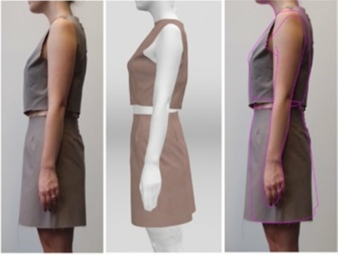21/04/2020 – Clothing technology — auf Deutsch lesen
HTW Berlin: 3D simulation of clothing
The HTW Berlin clothing technology course is increasingly concerned with the 3D simulation of clothing.
Last winter semester, two student projects in the clothing technology study course at HTW Berlin were headed by Prof. Dr.-Ing. Thomas Schneider and Ulrike Reinhardt on the subject of 3D simulation of textile surfaces and clothing. Many thanks to our industrial partners – botspot GmbH, Avalution GmbH, Assyst GmbH, Lectra, CLO Virtual Fashion Inc., Browzwear and GRAFIS Software Dr. K. Friedrich GbR – without their cooperative cooperation, project implementation in this form would not have been possible.
In the “Applied Research” project, students of the master's program developed the concept for a material database. Through the most accurate representation and description of the materials, a material database would ensure the permanent provision of information and could be an opportunity for inspiration. This activates and facilitates the product development process. Furthermore, the repetition of mostly complex material tests can be dispensed with. Material libraries are therefore of particular importance in the entire product lifecycle, from the design process to product development, production, marketing and recycling.
To date, there is no material database available in the Department of Design and Culture at HTW Berlin, to which the clothing technology / clothing study course is assigned. With their work, the students have laid the foundation for the establishment of such a database, which should be used as extensively and interdisciplinary as possible. That is why it was designed in both analog and digital forms. With regard to the 3D simulation, which is becoming increasingly important in the clothing industry, the relevant material properties should be considered in particular. First, four different simulation programs were considered – Assyst Vidya, Lectra Modaris, Clo3D and VStitcher from Browzwear – and it was found that there are no uniform guidelines for determining the material parameters and their implementation in the programs. Furthermore, the relevance of the individual material parameters and the methods and modes of operation of the simulation remain unknown to the user and can therefore not be assessed sufficiently well. These inconsistencies with regard to the determination of the parameters and their influence on the simulation has been demonstrated in an experiment in which the material properties were determined both according to the company-specific method of a selected simulation program and according to DIN standards and the test results were then compared. Although the same properties were tested, the values determined differed significantly from one another, but no significant difference could be found between the simulations. The results of this project show, therefore, not only the need of the development of a database concept, but also the determination that there is still a considerable demand for research into the area of simulation of textile fabrics.
The university says thank you!
Because without the support and cooperative collaboration of the industrial partners – botspot GmbH, Avalution GmbH, Assyst GmbH, Lectra, Clo Virtual Fashion Inc, Browzwear and Grafis Software Dr. K. Friedrich GbR – project implementation in this form would not have been possible.
Read the detailed article by Ulrike Reinhardt in the forthcoming print edition of textile network with the new publication date 17 June 2020.



